This Friday saw us having to attend a virtual seminar owing to some March snow falling around and about on the Thursday and Friday. It would have been dangerous to attempt attending the Uni so Alice organised for us to attend online ina. teams meeting.

Learning outcomes from today’s session were to be:
- Identify the key definition for ‘Performance Art’.
- Reflect on how performance concerns you on an individual level and as an artist/photographer too.
- Analyse and discuss the work of four key artists and photographers whose work involves performance.
- Evaluate the extent to which your knowledge of Performance Art has developed.
Alice started off by suggesting we look at a catalogue of an exhibition called Performing for the Camera by Simon Baker and Fiontan Moran, which holds a huge amount of examples of work from an exhibition at the Tate containing works by Yves Klein, Lee Friedlander, Eikoh Hosoe and Amalia Ulman to name a few. The video of the overview can be found here: LINK
Alice then changed the slide and asked us to answer some questions. My responses are between the questions.
Do you perform?
I do. I am always on my best behaviour at work, always guarded with my responses to the sometime silly questions I am asked. At work I always tell people I’m Ace or Amazing, even if I don’t feel like it on the day.
Where do you perform?
I perform at Work and sometimes when I’m out at other people’s houses or parties etc. I do and say things that I wouldn’t normally do. I perform as a quieter version of myself at university as I feel a little bit of an outsider being a lot older than many of my classmates.
I’ve performed with my unicycling and also on tv game shows, where I’m not really the quiet and introverted person, but seemingly gregarious.

How often do you perform?
Regularly, often many times daily. I always put on a brave face even if times are challenging. If I find myself in unusual situations I’m almost always performing either to appear more confident.
Who do you perform to?
I perform to people I don’t know well, I don’t over perform or over exaggerate, but mostly under perform so that I don’t upset people with my sometimes sick sense of humour.
Who are you when you perform?
When I perform I am not the real me. I’m an exaggerated version of me or a quieter version, picked for the occasion. At parties and events I never feel like me, as I’m careful not to do something that makes me look too daft. When I’ve been the MC on the Carnival float in the annual carnival I turn into a standup comic, singer and dancer, childrens entertainer and all round clown. It’s like an alter ego.
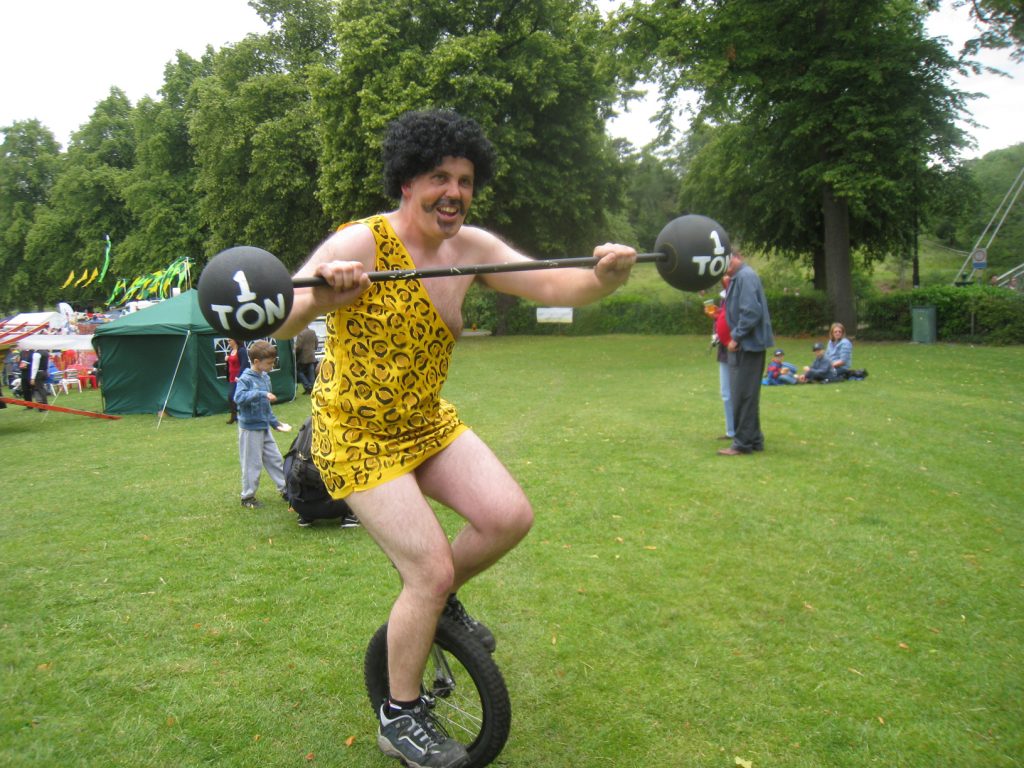
Why do you perform?
I used to perform to make people laugh, but I don’t feel that is a good reason to make myself look super foolish. I more often perform now so that I can motivate people by appearing more confident than I feel or sometimes just to allow people to have their say.
My answers were not uncommon and they sat along with the rest of the class although Alice said that sometimes many people say they don’t perform.
Poll
Alice asked us a poll question in Teams: How would you score your current knowledge on Performance Art, out of 10?
0 = no knowledge at all and 10 = comprehensive knowledge
I chose 2 as my response as I don’t feel I know a massive amount about performance art but was looking forward to learning more about it.
The poll results came in :

As you can see there were some people in the class who rated themselves as an 8 which was impressive. I was eagerly anticipating their knowledge sharing.
Another bunch of questions then to complete and share the answers with the group.
What do you think Performance Art is?
Performance art is the creation of art using a process and the art contains all of the work that goes into the process too.
Have you seen any examples of Performance Art before?
I’ve seen people making artworks paintings and it’s a performance to see them working. They may also be doing things they wouldn’t normally do in the process.
If yes, where? What did it look like? What did you think of it?
I’ve seen many musicals, movies etc that I really enjoyed and then some things that I find strange and not very interesting at all.
Do you know any performance artists? Can you share their names?
I don’t know any performance artists names really, other than perhaps artists who make their bodies into the artwork, also artists who release documentaries of their works are kind of performing too.
Who is involved in performance art?
Everyone is involved in Performance art, the artists and the audience.
Gin and Leah stated some information about performance art and that there was a piece consisting of a robot cleaning up a fluid incessantly which they considered to fit the category. I had a look at the video of it and found it fascinating and futile. Sun Yuan and Peng Yu: Can’t Help Myself is the video of the installation.
Alice then explained what Performance Art is defined as by Tate organisation
Performance: ‘Artworks that are created through actions performed by the artist or other participants, which may be live or recorded, spontaneous or scripted.’
I considered other artists that could be thought of as Performance Artists and came up with a list:
Dean Kelland a former lecturer at Wolves and he engages in performing in his works.
Also Banksy with the shredder work, Dismaland etc..
It’s important to note that Live performances happen once and then it’s gone.
Recording the Importance
We talked about the importance of recording performances.
Why might it be important for artists to record performative works?
It is often recorded so that the art can be shared after the event, keeping some evidence of the work.
Does it matter it the performance is not recorded?
I thought that it didn’t matter if it wasn’t recorded, an artist sometimes gets grumpy when it’s being recorded rather than enjoyed in the moment
Alice mentioned a quote by Marina Abramovic as a way to distinguish Theatre/Musicals/Plays etc from Performance Art

We then went into looking at work by performance artists/photographers.
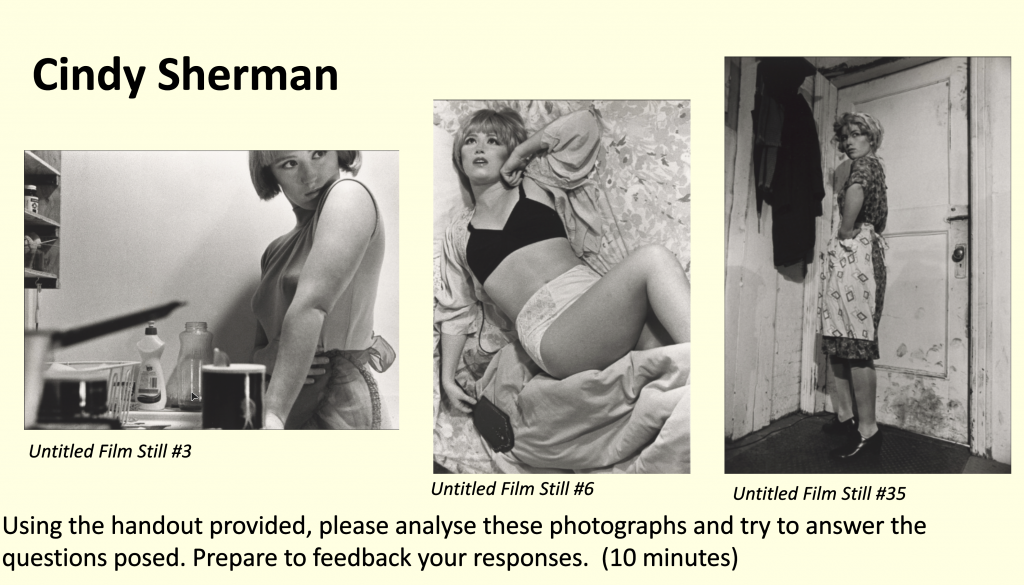
What is the Ambition/Message the artists wants you to think about
What?
Photographs of herself in similar poses to those seen in movies, where she represents women that have appeared in the old hollywood movies.
Where?
No clue as to where these were photographed, but some of her work is done on location in America etc to recreate some film scenes.
Why?
I can’t remember why she made these but I think it was to empower the character of the woman in the films of the time that are being represented as they were usually not very consequential characters. She was trying to make them more prominent and have more agency.
How?
Some look like they’re made in a studio and others are on location, using black and white film photography, self portraits mostly so probably no assistants.
Who?
Self portraits of Cindy Sherman, designed to look like different actors from the films of the day.
Alice pointed out that the character in the photo is not Cindy Sherman, but a representation of another woman by the performer Cindy Sherman. I found it interesting that they’re not considered Self Portraits as they represent other people.
Alice shared a MoMA video Untitled film stills. and there is another here that explains more about Sherman’s work.https://www.youtube.com/watch?v=iCpGdbyxRdw
https://www-jstor-org.ezproxy.wlv.ac.uk/stable/26284559?sid=primo The book Auteurs as Autobiographers: Images by Jo Spence and Cindy Sherman, written by James Guimond
With this work she has Mined stereotypes of all different sorts of women and represented them as cheap and massively produced prints that were made cheap to be thrown away as the publicity shots would have been.
Alice then shared a few more Sherman Untitled Stills with us as can be seen from Alice’s slide below and asked us to analyse the two images.
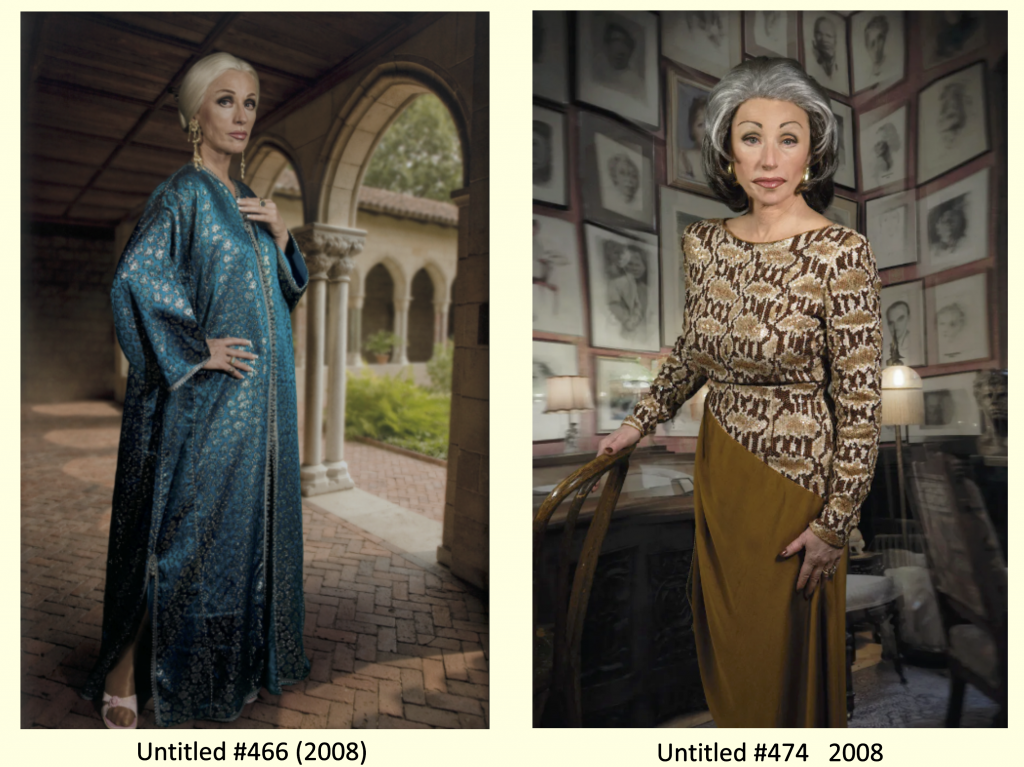
What is she commenting on?
I thought it was a bit Gillian Wearing, like she was recreating a pose of another photograph, but I doubt she’s doing that. It did look a little uncanny valley too.
They look like Business Photos, Linked In Profile pictures that sort of thing, I wonder if she’s mocking people’s Linked In Profile Photographs, or Facebook photos….
The blurriness of the second shot is off putting when she is sharp and it looks like it’s been edited.
They actually look like Politician’s photographs. Showing the power that women have grown to achieve today
Video, Helene Winer on Cindy Shermans untitled 474 MoMA
Portrait of someone for a magazine , or almost painting like. It’s a comment on the aging process and how men’s gaze is way different to the female gaze. It’s a description of people trying to battle aging by use of make up etc.. When we see the photos in the museum/gallery we are inspecting them.
She explained how the images were meant to represent commissioned portraits of wives of powerful men. It’s a little sad to see the efforts these women will go to to keep up appearances so they represent their husbands well. It’s obviously false, fake and uncanny. It was thought that the pink coloured shoe in #466 was too small for the foot, and the facial makeup in #474 was a little OTT.
Amalia Ulman
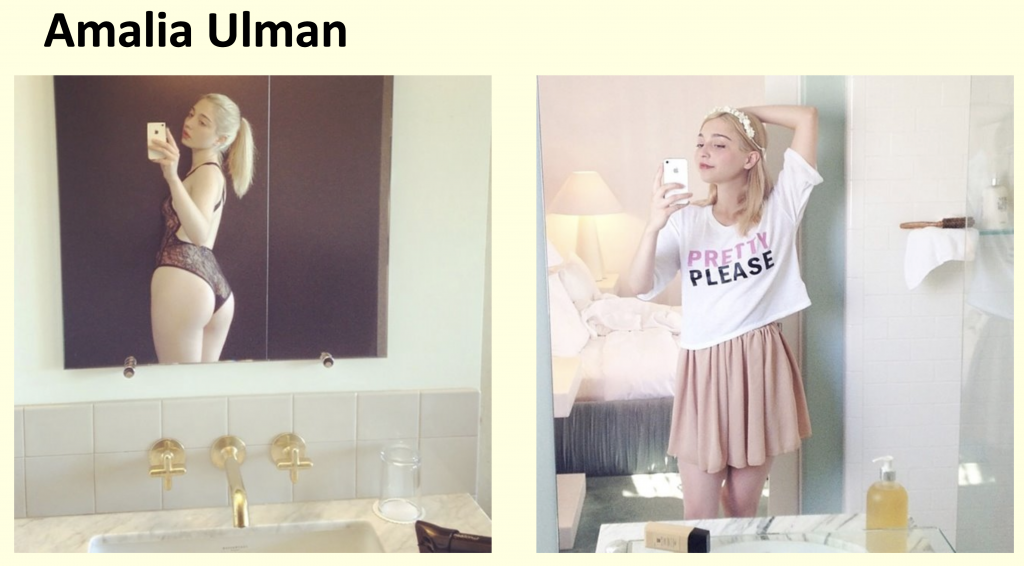
We were asked if we knew of Amalia Ulman, and I’d never heard of her. Alice showed us the slide above and asked us to interpret what they meant, what the contents of the work could be.
We all agreed on the fact that they looked like Instagram Lifestyle Influencer images.
T shirt in the second is right way around, phone flips around.
Instagram Square format.
Social media self portraits
The photo on the left was racier than the one in the tshirt but they represent photos that many of the youth of today post daily on Instagram and other social media.
The Truth was shared with us then that Ulman had faked an instagram account for four months building up 90k followers telling a story that she carefully curated before revealing the real reason behind the account and contents.
The full Instagram story can be seen here at this link but it shows a young woman starting off as an innocent and then going through a story of multiple moods and appearances including some significant life events, fake though.
Alice then posed the question as to whether we considered this as Art and what our thoughts were about it.
- Art is something that has been planned in the beginning?
- Something that has a goal
- Intentions are important
- Doesn’t have to result in a negative meaning.
Yves Klein
Leap Into The Void photo was shared with us and we were asked to analyse it to see why it might be considered performance art.
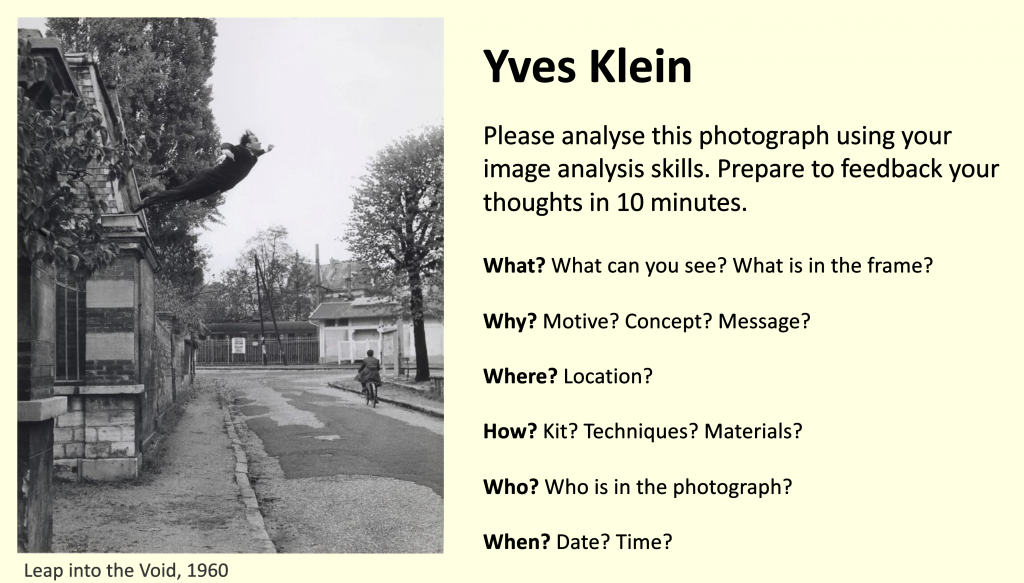
To me it appeared to be an image of a man jumping off a wall or falling from a wall. There was a cyclist travelling away from the camera and it was photographed in a side street in a seemingly French or European town or City. It could have been an early attempt at Parkour as I know that originated in France.
I felt like the image was taken to trick people into making it look like he was falling and using higher shutter speeds that may not have been available much before then.
It looked like it was taken on a big field camera and if it is a self-portrait of the artist then someone must have helped him with the shutter release.
The curtain was thrown back and the truth unveiled to us again with a behind the scenes page, showing two photos, one of the street empty and another of Klein leaping off the wall into a tarpaulin held up by multiple other people. The image was then merged with the upper and lower parts to create a seemingly real image of a man flying. It was noted his head was facing up as if he was just launching to take flight and clear the trees on the other side of the narrow road. He did this as part of a false newspaper release to see how far the story would go.
Samuel Fosso
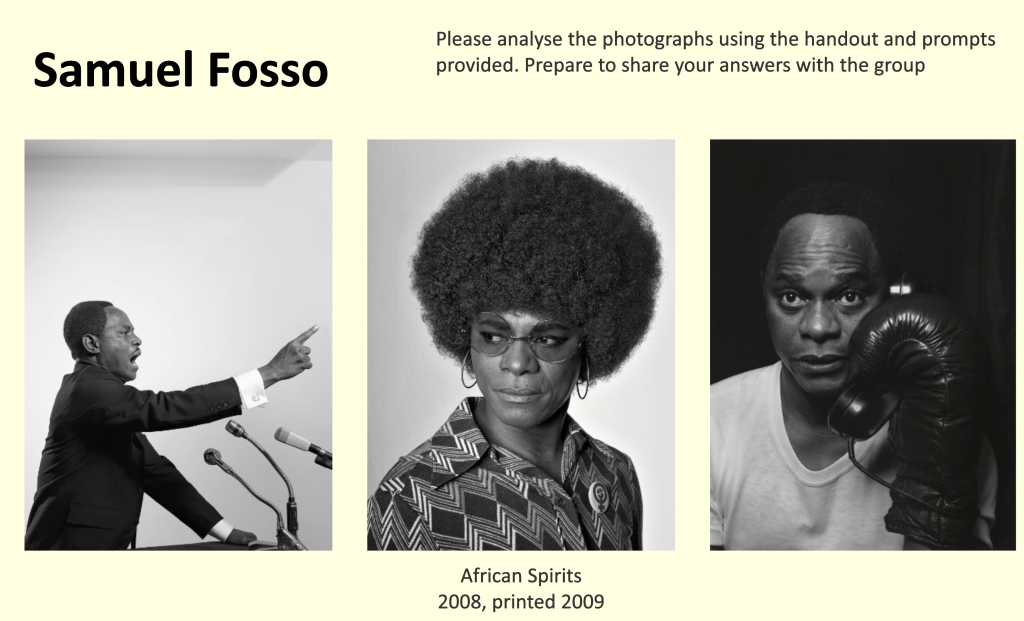
Alice presented a slide showing these three images made by Fosso and asked us to consider them.
- Represents black people as if recreating a famous image of MLK, an activist and Muhammad Ali.
- The MLK style image is reminiscent of a photo of Hitler that I’ve seen in the past too.
- Look like self portraits, wearing costumes with props etc.
- Looks like sixties perhaps and showing the rise of equality or the fight for equality and social justice.
- I thought of the first being MLK represented, but I’m certain I’ve seen images of Hitler in a similar stance.. The last one looks like Ali with his innocent gaze and gloves.
- The middle photo looks like one of the female activists that were imprisoned for rioting in a US State.
- feels like a BLM message, but showing that these appear to be the last time important black people were in evidence.
- We haven’t moved on far

His work speaks of Slavery and the people represented in his slef-portraits as people who fought to achieve freedom for black people in a time when segregation and prejudice was considered normal.
Reflection
More prompts from Alice to get us thinking more about how we might use performance art in out practice going forward.
How would you score your knowledge of performance art, out of 10?
I chose 5 as it was improved a little, I actually did know Sherman and Klein but wouldn’t have ever considered them as performance artists but I know differently now.
Has your perception / appreciation of Performance Art changed at all?
My perception of Performance art has been changed from the defintion removing the theatre and movies from the category. I will consider performance when I analyse new works.
Does your year long project have any performative elements to it?
Talking to Niki, yes. My weaving of images together is a performance and it remains a performance even if nobody is there to witness it. By dropping film in puddles or damaging them I am also creating a performance but I might not have ever considered this before.
Have you considered this within your independent research?
It was not something I considered in my independent research but I had spoken to Niki about it the week before but I will look out for this in future research.
Is there potential to explore performance in your work?
I could record the process more closely when I weave some images together or if I create a jigsaw then it could be the separation and rejoining of the pieces that is the performance.
Where and how could it work?
I could do a time lapse of the work being created, I’ve done these before on different events so could recreate the process of the build and use this as a performance.
Essay Reminder
The final thoughts of the session before lunch time was that we should spend some time getting our essay introduction uploaded to canvas in the afternoon so we can receive some feedback on it from Alice. I uploaded my intro as can be seen below and I include the helpful prompts that Alice gave me to improve and create a more comprehensive intro.
Essay Title: Does regular exposure to family photo albums create corrupted or false childhood memories?
Since the year 2000, the Griffiths digital family photo archive has been growing with daily additions of photographs, consisting of an eclectic range of subjects containing family, cars, houses, holidays, and numerous important life events. They are all safely stored on a NAS (Network Attached Storage) device and a random slideshow of the 100,000+ collection of pictures is displayed on the main television in the living room when it is idle.
Previous family discussions have resulted in questiona as to whether a particular moment in time a photo was captured is accurately remembered by the family’s two, now grown-up, children. Do they remember the actual event, or has the photograph implanted fictional memories or prompted them to remember the event more accurately than they had previously recalled.
This essay will explore whether false memories and confused recollections are possibly created as a response to seeing family photographs too frequently? Should family album usage be limited to a less regular occurrence?
Alice’s feedback:
“This is reading really well, I think it would be good to see if you can perhaps mention some (one or two perhaps) of the key sources you might call upon in your essay, or to insert a quote that potentially comments on the nature of memory and photography?
Keep going! “
Conclusion:
The Teams Meeting format worked well and everyone seemed to get on with it ok, Alice gave everyone ample opportunity to have a say and used the tools in the Teams app effectively. I was surprised how well it went given that I’ve been in some teams meetings before that seemed to be a huge problem.
Performance Art is more widespread than I first thought and it has way more levels of meaning than might be immediately obvious.
I will consider whether an artwork is a Performance Art Piece when I’m looking at them in the future.
My essay intro needs more quotes, citations etc to make it read more like an academic essay. The next version now has a couple of quotes but I will document the changes in a future post.
Comments are closed.